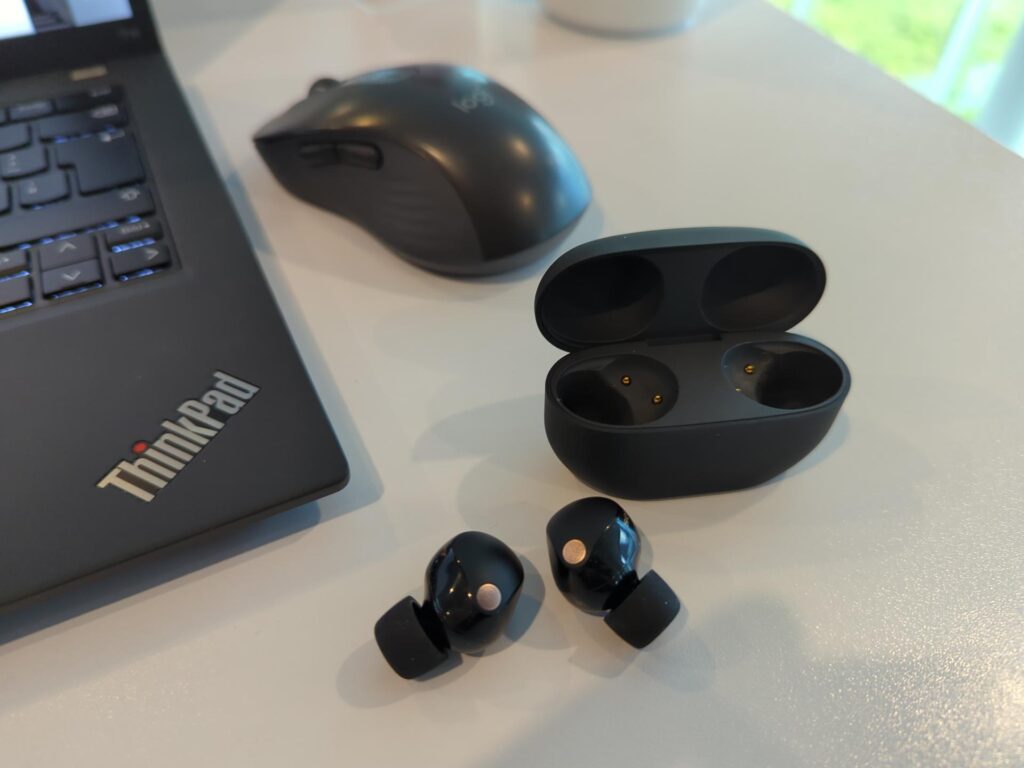
In my life there is a time before noise cancellation headsets and the time ever since, as noise cancellation has brought so much more silence, peace and concentration when I’m in noisy city, home and office environments. As my current first generation Bose in-ear noise cancellation headset I’ve had for many years are showing signs of battery fatigue and charger connector problems, it was time to look for something new. After shopping around a bit, the two contenders for my refresh where either the latest generation Bose in-ear Bluetooth headset, or the latest Sony variant. In the end, I decided to go for the Sony WF-1000XM5 and I’ve been using them for around 2 weeks now. Was it a good choice? I’m not so sure…
After careful consideration, I decided to go for the Sony because of one major feature the Bose headset seemingly does not have: Simultaneous multi-device connectivity. In practice, I use my in-ear noise cancellation headset with two smartphones, a tablet and notebook. And truth be told, while I love the Bose headset, it is a major pain to switch between devices, as the headset started to cycle through all known devices if the last one it was connected to was not found. With four devices it just takes too long and the process often ends up on a device I don’t want the connection to be. The Sony WF-1000XM5, however, can be connected to two devices simultaneously and if I want to use it with a third device, I initiate a connection to the headset and a connected, but not used device, is disconnected automatically.
Also, in my personal opinion, the Sony in-ear headset has a number of other advantages over my first generation Bose in-ear:
– A much smaller charger and storage case: It is actually so much smaller that I had to find a different place in my backpack to be able to quickly retrieve it. Very nice!
– Incoming calls from the smartphone that is simultaneously connected can interrupt a music stream from another device. However, there’s a catch: If I listen to music on the phone and the headset is connected to the PC, the music is interrupted any time a sound notification is played on the PC.
Unfortunately, there are a number of negative things compared to the Bose which I found out while using them in the last two weeks:
– The Sony’s have to be pressed into the ear canal to stick and insulate. While this works well in general, it is by far not as comfortable as the method used by the Bose headsets. Here, a conic rubber insulation is pressed on the outside and entry of the ear canal instead of the inside. This feels much more comfortable to me, particularly when wearing the headset for many hours.
– Another major disadvantage of applying pressure inside the ear canal becomes immediately apparent when using the headset while walking in the street or while jogging: There’s a constant “Thud – thud – thud” noise caused by the feet hitting the ground. Totally unnerving.
– The Sony only has two settings for noise cancellation: On and off. The Bose on the other hand has those and a middle setting. During many occasions, this setting allowed me to hear what was going on outside while reducing the overall unnerving volume.
– When showing emotions on your face like broad grins, the ear canal insulation becomes ineffective and noise cancellation is interrupted. This can be fixed by using the next size of the in-ear plugs, but this also increases the pressure.
So after 2 weeks I’ve started to regret my choice. The Sony is really great in many respects, but the ear canal pressure and the ‘thud – thud – thud’ sound while walking just doesn’t work for me. So it’s back to my old Bose’s until I can come up with a new solution.